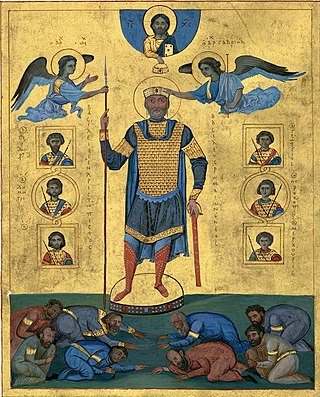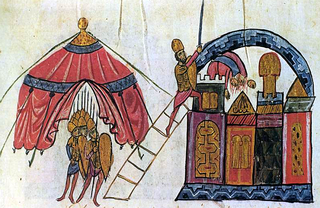
Basil II Porphyrogenitus, nicknamed the Bulgar Slayer, was the senior Byzantine emperor from 976 to 1025. He and his brother Constantine VIII were crowned before their father Romanos II died in 963, but they were too young to rule. The throne thus went to two generals, Nikephoros Phokas and John Tzimiskes before Basil became senior emperor, though his influential great-uncle Basil Lekapenos remained as the de facto ruler until 985. His reign of 49 years and 11 months was the longest of any Roman emperor.

Isaac I Komnenos or Comnenus was Byzantine emperor from 1057 to 1059, the first reigning member of the Komnenian dynasty.

John Tornike, also known as Tornike Eristavi was a retired Georgian general and monk who came to be better known as a founder of the formerly Georgian Orthodox Iviron Monastery on Mount Athos in modern-day northeastern Greece.
Bardas Phokas was an eminent Byzantine general who took a conspicuous part in three revolts for and against the ruling Macedonian dynasty.

The Battle of Pankaleia was fought in 978 or 979 between the army loyal to the Byzantine emperor Basil II, commanded by Bardas Phokas the Younger, and the forces of the rebel general Bardas Skleros, which ultimately led to the defeat and exile of the latter. Sources are unclear in the succession and location of the events, so that while earlier scholars followed John Skylitzes in placing the Battle of Pankaleia in March 979 as the decisive victory for loyalist forces, today, following Leo the Deacon's account, it is placed in June 978 and regarded as a defeat for Phokas.

Peter was a Byzantine eunuch general. Originally a servant of the powerful Cappadocian Phokas family, he was raised to high military office under Emperor Nikephoros II Phokas, leading the capture of Antioch and the subjugation of Aleppo in 969. Under John I Tzimiskes, he fought as a senior commander against the Rus' in 970–971, while after Tzimiskes' death he led the loyalist forces against the revolt of the general Bardas Skleros in Asia Minor, falling in battle in autumn 977.
Michael Bourtzes was a leading Byzantine general of the latter 10th century. He became notable for his capture of Antioch from the Arabs in 969, but fell into disgrace by the Emperor Nikephoros II Phokas. Resentful at the slight, Bourtzes joined forces with the conspirators who assassinated Phokas a few weeks later. Bourtzes re-appears in a prominent role in the civil war between Emperor Basil II and the rebel Bardas Skleros, switching his allegiance from the emperor to the rebel and back again. Nevertheless, he was re-appointed as doux of Antioch by Basil II, a post he held until 995, when he was relieved because of his failures in the war against the Fatimids.
Eustathios Maleinos was a leading Byzantine general and one of the wealthiest and most influential members of the Anatolian military aristocracy during the late 10th century. He held senior administrative and military posts in the East, and was involved in the aristocratic rebellions against Emperor Basil II, fighting against Bardas Skleros but supporting the revolt of his nephew Bardas Phokas. After the failure of the latter, he was not punished, but his immense wealth caused his eventual downfall, as Basil II confined him to a mansion in Constantinople and confiscated his wealth after his death.
The Battle of Petroe, also known as the Battle of Hades, was fought on 20 August 1057 between two rival Byzantine armies: the loyalist forces of the Byzantine emperor Michael VI Stratiotikos under the proedros Theodore, and the supporters of the rebel general Isaac Komnenos.
Phokas or Phocas (Latinized), feminine form Phokaina or Phocaena, was the name of a Byzantine aristocratic clan from Cappadocia, which in the 9th and 10th centuries provided a series of high-ranking generals and an emperor, Nikephoros II Phokas. Its members and their clients monopolized the high-command positions of the Byzantine army for much of the 10th century and led the successful Byzantine offensive against the Arabs in the East. As one of the leading families of the Anatolian military aristocracy, the Phokades were also involved in a series of rebellions that laid claim to power and challenged the emperors at Constantinople. Their power was eventually broken by Basil II, and the family declined in importance after the 11th century.

The Skleros, latinized Sclerus, feminine form Skleraina (Σκλήραινα), Latinized Scleraena, was a noble Byzantine family active mostly in the 9th–11th centuries as members of the military aristocracy, and as civil functionaries thereafter.

Manuel Erotikos Komnenos was a Byzantine military leader under Basil II, and the first fully documented ancestor of the Komnenos dynasty. His origin and parentage is obscure. He is only mentioned in the sources as leading the defence of Nicaea in 978 against the rebel Bardas Skleros, and as an imperial envoy to him 11 years later. He had three children, late in life. The eldest, Isaac, became emperor in 1057–1059, and the youngest, John, was the progenitor of the Komnenian dynasty as the father of Alexios I Komnenos.

Gregory Taronites was an Armenian prince of Taron, who went over to Byzantine service and held senior commands and governorships under Emperor Basil II. He was killed by the Bulgarians at an ambush near Thessalonica ca. 991 or 995.
Nikephoros Phokas, surnamed Barytrachelos, was a Byzantine aristocrat and magnate, the last major member of the Phokas family to try to claim the imperial throne. He was a son of the general Bardas Phokas the Younger and great-nephew of Emperor Nikephoros II Phokas, and played an active role in his father's failed rebellion against Basil II in 987–989. After the death of his father, he sought and received Basil's pardon. Nothing further is known of him until 1022 when, along with the general Nikephoros Xiphias, he launched another rebellion. The revolt gathered widespread support, but mistrust between the two leaders led to Phokas' assassination by Xiphias on 15 August 1022. The rebellion collapsed quickly after that.
Michael Kourtikios was a senior Byzantine military commander and a partisan of Bardas Skleros during the latter's rebellion against Basil II.
Bardas Parsakoutenos was a Byzantine commander and nephew of Emperor Nikephoros II Phokas.

The Rebellion of Bardas Phokas the Younger was a major war within the Byzantine Empire, fought mostly in Asia Minor.

The Duchy of Antioch was a Byzantine territory ruled by a duke (dux) appointed by and under the authority of the emperor. It was founded in 969 after the reconquest of Antioch by imperial troops and existed until December 1084, when Suleiman ibn Qutalmish of the Sultanate of Rum conquered the ducal capital.












